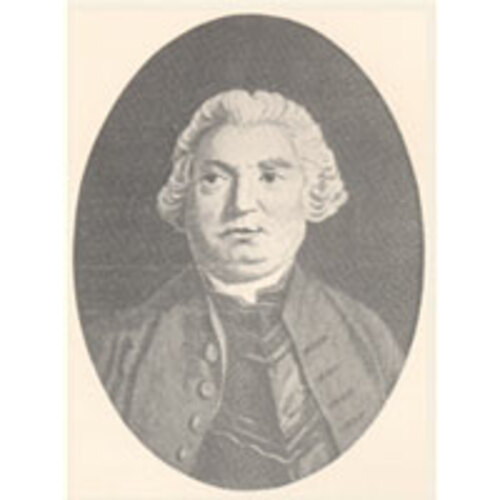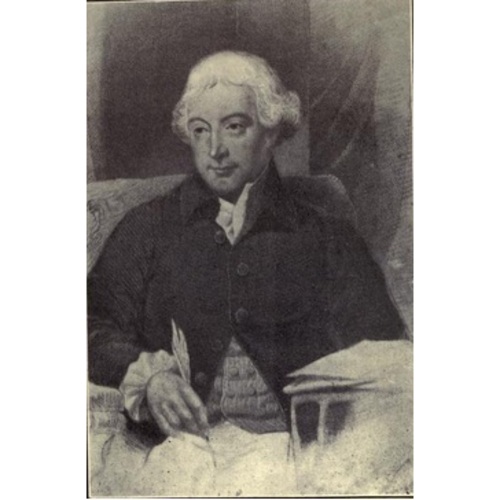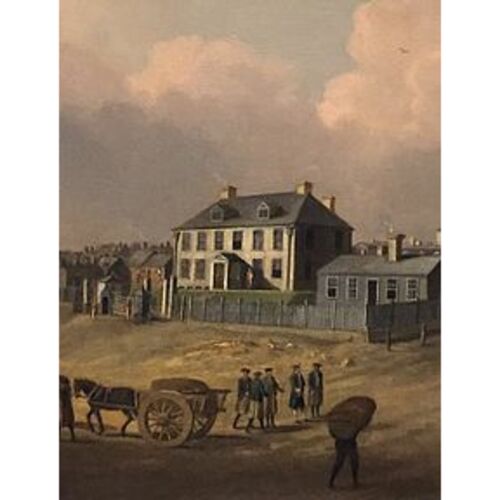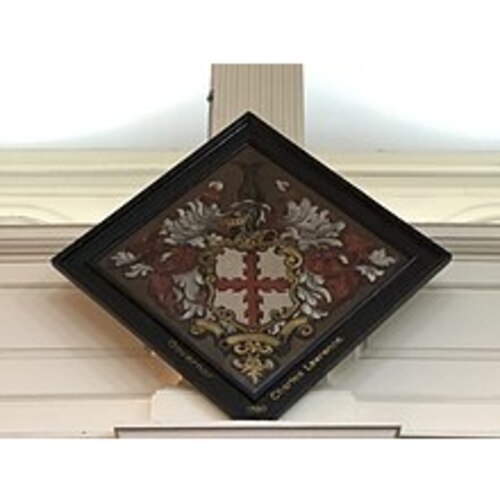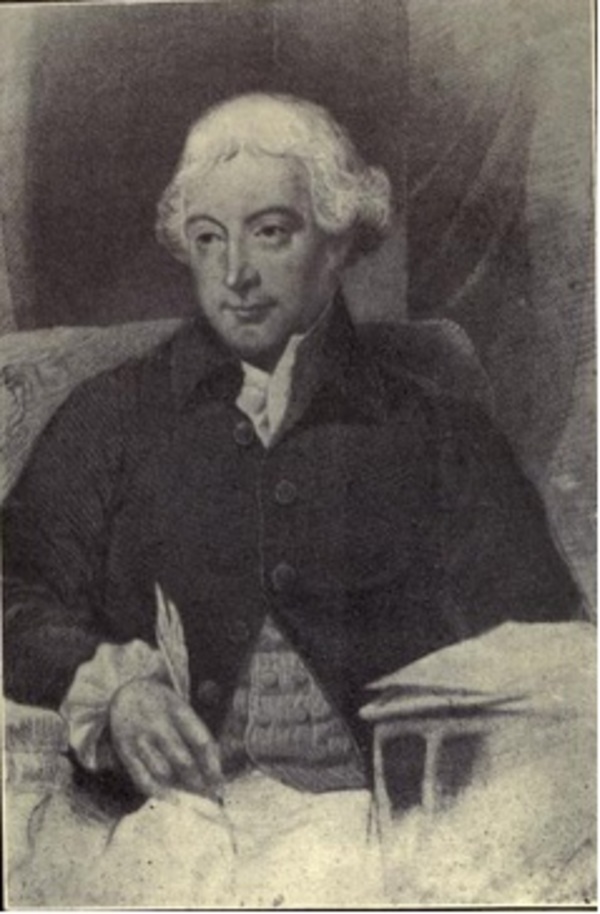
Source: Courtesy of Wikimedia Commons
LAWRENCE, CHARLES, military officer, governor of Nova Scotia; b. c. 1709 in England, son of Herbert Lawrence; d. Halifax, Nova Scotia, 19 Oct. 1760.
Charles Lawrence’s life before his arrival in Nova Scotia in July 1749 is obscure, and existing accounts of it are inaccurate. It seems that he was commissioned in the 11th Regiment of Foot in 1727, was in the West Indies from 1733 to 1737, and then served in the War Office. He was promoted lieutenant in 1741 and captain in 1742, and fought with the 54th regiment in 1745 at Fontenoy (Belgium) where he was wounded. He was gazetted major with the 45th regiment (Warburton’s), and joined it at Louisbourg, Île Royale (Cape Breton Island), in 1747. His family was related to the Montagus, which partly explains why he enjoyed the patronage of George Montagu Dunk, 2nd Earl of Halifax, president of the Board of Trade. This connection was his only source of influence, however, and he was without private means. He was popular in the army and was known to be strong, energetic, and direct in his methods.
Lawrence became a company commander in the 40th regiment in Nova Scotia in December 1749. The following April Governor Edward Cornwallis* sent him with a small force to establish British authority in the isthmus of Chignecto. On the north bank of the Missaguash River Lawrence found French forces under Louis de La Corne, who had orders to prevent British penetration beyond that point and who had had the village of Beaubassin, near the south bank of the river, burned. Rather than fight the French, with whom the British were not at war, or admit to any territorial limitation, Lawrence withdrew.
Authorities in London were divided on the question of how far their troops in Nova Scotia should proceed in peace time in establishing British claims to the whole of Acadia. The Duke of Bedford, secretary of state for the Southern Department, had refused to reinforce Cornwallis so that he could implement these claims. But the Duke of Newcastle, prompted by Lord Halifax, intervened and despite royal opposition ensured that the 47th regiment was sent to Cornwallis in June 1750. Lawrence was promoted lieutenant-colonel about this time, and in August he left for the Missaguash River with a stronger force and routed a group of Indians led by the Abbé Jean-Louis Le Loutre*. Captain John Rous, the naval commander supporting the landing of troops in this engagement, was full of praise for Lawrence’s coolness and leadership under fire. Cornwallis, in dispatches to London, commended his tactics. In the fall of 1750 Lawrence built Fort Lawrence on the south bank of the river. He remained there through the following year, and returned to Halifax in 1752, about the time that Peregrine Thomas Hopson succeeded Cornwallis as governor.
In the summer of 1753 Governor Hopson chose Lawrence to direct the settlement of the European Protestants who had waited vainly since their arrival in Halifax in 1751 and 1752 for the land promised them. Hopson decided to settle them on the coast south of Halifax at Mirligueche, renamed Lunenburg. There the French would not be able to stir up trouble for them, although Indian raids were to be expected. Lawrence accompanied the settlers to Lunenburg in June and supervised the establishment of the colony.
The settlers found cleared land, but most of the work remained to be done. Soured by months or years of waiting in squalid huts in Halifax, they were impatient to stake their claims and to start cultivation. Lawrence had seen the effects of Indian raids in different parts of the province and had to persuade the settlers to build defences before anything else. It was human to ignore a danger which few of them had experienced and it required artifice on Lawrence’s part to make them do communal work. “Decent people,” he noted, had to be cajoled into sleeping in communal shelters for protection and sharing them with those who were “dirty [and] full of Vermin.” Building supplies were pilfered and fights over favoured sites were frequent. But little by little this “inconceivably turbulent” crew was brought to see that they must either “proceed in another manner, or have [their] throats cut.” By a mixture of bribery, bullying, and verbal persuasion, Lawrence gained their affection – “not only their hats but their hearts,” as he described it – and retained it, to his political advantage, after his return to Halifax in August 1753. By then Hopson was preparing to return to England and had summoned Lawrence back as president of the council.
In 1754 Governor William Shirley of Massachusetts approached Lawrence with a plan to drive the French troops out of their Chignecto forts. Both men were sure of Lord Halifax’s support and took advantage of an ill-advised letter from Thomas Robinson, the new secretary of state, ordering them to cooperate to throw the French out of Acadia. Robinson later repudiated the letter, but Shirley used it as authority to plan an operation. Late in the fall of 1754 he and Lawrence raised two battalions in Massachusetts, giving the command to Lieutenant-Colonel Robert Monckton*, assisted by the New Englander John Winslow*. This force was to attack Fort Beauséjour (near Sackville, N.B.), which the French had built on the north shore of the Missaguash River, opposite Fort Lawrence. Without authority, Lawrence paid for the force with the annual parliamentary grant for Nova Scotia. Early in 1755 General Edward Braddock, commander-in-chief in North America, sailed for America with flexible orders for the removal of French “encroachments” given him by the Duke of Cumberland, commander-in-chief of the army. Braddock was permitted to undertake several operations against the French simultaneously if he had sufficient troops. He authorized Monckton’s expedition and it sailed from Boston on 19 May 1755. Fort Beauséjour fell to Monckton on 16 June.
The capture of Beauséjour was the only British success that year, but Lawrence had no orders for exploiting it. Braddock was killed near Fort Duquesne (Pittsburgh, Pa.) early in July [see Daniel-Hyacinthe-Marie Liénard de Beaujeu], while Shirley, his second in command, was proceeding towards Fort Oswego (Chouaguen) for operations against the French. In June, off Louisbourg, Vice-Admiral Boscawen let most of the French fleet escape with reinforcements for Louisbourg, Quebec, and Montreal. In an atmosphere of doubt about his superiors’ activities and intentions and of apprehension about the enemy’s, the defence of what he had gained became Lawrence’s main concern.
As early as 1 May the Nova Scotia Council had considered how to deal with the Acadians north of the Missaguash once Beauséjour had fallen. Those who had deserted to the French under the blandishments of Le Loutre could be punished for breaking their limited oath of allegiance to George II [see Richard Philipps] if they had taken up arms or assisted the French. The other Acadians in this area could be required to depart to whatever destination the defeated garrison chose. The decision to expel all these Acadians was formally taken by the council on 25 June. The council planned to put settlers from New England on the vacated Acadian lands of the Chignecto isthmus as a barrier between the French in Île Royale and Île Saint-Jean (Prince Edward Island) and the Acadians remaining on the Nova Scotia peninsula. A military force in Chignecto would raid northwards and eventually enable the rest of Acadia beyond the Missaguash (present-day New Brunswick) to be settled. This was also Lord Halifax’s conception.
John Winslow was the linchpin of the plan to obtain New England settlers. But owing to Lawrence’s uncertainty about how to exploit his victory, Winslow was not permitted enough time to survey the land around Chignecto after the fall of Beauséjour. Inactivity caused the discipline of Winslow’s troops to collapse and he quarrelled with Monckton, who had been ordered to recruit New Englanders for the regular battalions. Shirley also raided their ranks for his own use on the American continent. Winslow became embittered and lost interest in settlement. Short of troops and under the impression that the French were going to counter-attack, Lawrence turned his attention to securing his communications with Chignecto and was thus forced to deal with the issue of the loyalty of the Acadians of the peninsula. The scene was set for the tragedy.
Lawrence learned from the correspondence of previous governors, such as Richard Philipps and Peregrine Thomas Hopson, that although he should not drive the Acadians into the arms of the French, he should not grant them tenure unless they took an oath of allegiance which included the promise to bear arms for the English king. There was to be no compromise with the principle that before receiving the rights of subjects, they must accept their duties, and that Acadians who had left the country could not return without taking the oath. Hopson had been told to demand the oath when the circumstances of the province allowed. It had been an assumption of Lord Halifax’s policy since 1749 that that moment would arrive when the French military presence had been removed from Nova Scotia. A change in the attitude of Acadian leaders after the French surrender at Beauséjour seemed to bear out this assumption.
Early in July 1755 a group of 15 delegates from Minas (Grand Pré region) came before the council to present a petition concerning the confiscation of their boats and arms that spring by Alexander Murray at Fort Edward (Windsor). Lawrence took advantage of their presence to demand of them an unqualified oath of allegiance. The Acadians were reluctant to believe that the English would at last enforce the oath or protect them from Indian and French reprisals if they now took it. Consequently they refused the unqualified oath without a general consultation with the populace of Minas. Lawrence and his council insisted that each man decide on the oath himself, and when they still refused to do so they were imprisoned. Exasperated by the Acadians’ intransigence the English became legalistic and felt compelled to pursue their course to the end. New Acadian delegates were summoned from Annapolis Royal and Minas to meet with Lawrence and the council, which included John Rous, John Collier, and Jonathan Belcher*. On 25 July the Annapolis delegates were told “they must now resolve either to take the Oath without any Reserve or else quit their lands, for that Affairs were now at such a Crisis in America that no delay could be admitted.” They and the Minas delegates refused the oath and on 28 July were “ordered into confinement.” The council, having resolved to expel all Acadians who rejected the oath, agreed that “it would be most proper to send them to be distributed amongst the Several Colonies on the Continent.” Admiral Boscawen and Vice-Admiral Savage Mostyn attended this meeting and assented to the council’s decision. Over the next few months most of the Acadian population of Nova Scotia was rounded up and transported to the American colonies, from Massachusetts to South Carolina.
The expulsion proved to have been as unnecessary on military grounds – with the subsequent capture of Louisbourg and Quebec – as it was later judged inhumane. Lawrence was not a cruel man, however, even if he lacked imagination. It is too simple to explain the decision as simply a matter of greed; legalism, deference to precedent, and over reliance on the collective responsibility of councils – marks of the age – provided an umbrella for it. The policies of the Board of Trade over the years, ambiguous in many respects, were specific in demanding the oath when the occasion arose. The unauthorized operation against Beauséjour provided the occasion. No military plan existed in London for the Nova Scotia operation, but after the expulsion Lawrence received no reprimand for acting without orders. His decision was made in that “motly state neither peace nor war” (Lord Holdernesse) which Nova Scotia had experienced since 1749. The chief elements in the affair were confusion, misunderstanding, and fear. Each step towards the tragedy created the facts which pointed to the next. At no time did those who had the power also have the information to decide aright. They planned in a vacuum. Indeed, the only note of irritation appearing in letters from London in the months after the expulsion was caused by the complaints of the American governors on whom the Acadians had been foisted with little or no notice. Lawrence had overlooked the administrative and social implications of what he had considered a military operation.
In July 1756 Lawrence became governor of Nova Scotia. He saw as his most important task the settlement of the Acadian lands. But by 1757 merchants who were opposed to his personal rule, such as Joshua Mauger* and Ephraim Cook, had convinced the Board of Trade that settlers would not come unless they had an elected assembly. They also tried to show that Lawrence had favoured his friends with contracts and offices and would not call an assembly for fear of exposure.
In October 1754 the Board of Trade had instructed Jonathan Belcher, on his arrival as chief justice, to inquire into the legality of enactments made without an assembly. He reported that the governor’s instructions did not make an assembly mandatory and pointed out that only one township would qualify for representation at that time. In fact, he added, an assembly would be a hindrance to the administration of the province. Both the attorney-general and solicitor-general of Great Britain, however, advised that without an assembly Lawrence’s acts as governor could be illegal. The board then instructed Lawrence to prepare a scheme for setting up an assembly, although it was aware that undue representation might be given to “dram-sellers” and contraband runners in Halifax, and that the Lunenburg settlers, who were not yet naturalized, could not be represented until 1757. The board also knew that an assembly might be a forum for the struggle which had broken out in Hopson’s time between the New England and British elements in the population. The correspondence about various schemes dragged on through 1755 and 1756.
The council finally hammered out a plan by which an assembly could be convened in April 1757. But Lawrence, who was stalling until he could get the Lunenburg votes, instigated a memorial, with only 11 signatures, demanding that the plan first be submitted to London. He then departed for Boston early in 1757 to meet Lord Loudoun [John Campbell], commander-in-chief of British forces in America, giving instructions that Monckton, president of the council in his absence, should issue writs for elections only if “he found the people pressing.” Monckton received a memorial but would not issue the writs. Angered, Belcher, Charles Morris*, and two others in the council petitioned the Board of Trade in March. In May the board also received a petition from the grand jury of Halifax and was finally persuaded that the issue had shifted from recognizing the rights of Englishmen to cleansing the administration. The petition accused Lawrence of bias against merchants and failure to advertise contracts, of preventing the council from examining his accounts and allowing offices to accumulate in a few hands. These accusations were familiar enough to the board, but they indicated that Lawrence was losing support.
Lawrence might have prevented the alliance between members of the council and the Halifax merchants simply by issuing the writs after his return from Boston in May 1757. But he claimed that Loudoun did not approve of assemblies and that he could not attend to the matter himself that summer because he would be involved in preparations for an expedition against Louisbourg. He went off to Chignecto in the fall, on Loudoun’s orders, to strengthen its defences. He was determined not to submit to pressure, lest he lose control of his government. In February 1758 the board finally ordered Lawrence to convene an assembly. When he received this order in May, he told the council he would issue writs for the autumn. He intended to fill council vacancies with his supporters, and hoped that the Louisbourg campaign, in which he was about to take part, would prove victorious and thereby restore his popularity.
Lawrence, with the temporary rank of “brigadier in America,” commanded a brigade under General Jeffery Amherst* in the successful expedition against Louisbourg. He returned to Halifax in September to help prepare the British forces for operations against Quebec in 1759. Stores were scarce but he improvised. Thousands of pairs of shoes were made, arms repaired, and light infantry units formed and trained. Lawrence paid special attention to feeding the troops and thanks to fresh meat, milk, spruce beer, and “our climate in spite of the opinions of the C.O.s,” the sick recovered. When James Wolfe, the commander of the Quebec expedition, returned in the spring, that critical young man had nothing but praise for Lawrence and his subordinates. Lawrence had hoped to command a brigade at Quebec; in the end the commands went to Monckton, James Murray*, and George Townshend*, that of the latter through political influence. It was a “mortifying situation” to be left behind, but Lawrence threw off his disappointment and turned to the problems of settlement and politics in Nova Scotia, which were less glamorous, but in the long run more important, than commanding a brigade on the Plains of Abraham.
The first meeting of the new assembly had taken place on 2 Oct. 1758, with 20 assemblymen present, and its business was conducted with surprisingly little trouble. Lawrence’s support on the council grew in August 1759 with the appointment of Richard Bulkeley*, Thomas Saul, and Joseph Gerrish*, to the seats left vacant by the absence of William Cotterell, Robert Grant, and Montagu Wilmot. In December the first Lunenburg representatives entered the assembly, and Lawrence received an address of praise from that body for his achievements in the province.
Lawrence’s aggressive policy for finding settlers had much to do with his success. He was supported by Charles Morris, the surveyor and council member, who was involved deeply in the settlement plans. Lawrence began the drive to settle the Acadian lands in October 1758 with a proclamation seeking proposals for settlement. In January 1759 a second proclamation informed would-be settlers of the actual terms they could expect. Each grant would combine cultivated land and wild woodland. One thousand acres was the maximum initial grant for each family, with further grants available when the terms of the first one had been complied with. The proclamations were directed mainly at New Englanders.
Settlers were reluctant to break new forest land while the marsh land of Chignecto and the cleared areas of the Annapolis valley were vacant. To resolve this difficulty, Lawrence preferred to combine old land with new in each grant and thus offered favourable conditions usually permitted only to those breaking in new lands. He had been instructed to submit proposals for settling the old lands to the Board of Trade, but he disregarded this directive and informed the board of his policies after the fact, as was his custom. The board was angry, but by the time it had explained that the good lands were intended as rewards for the army and navy, Morris had surveyed lots with representatives of “some hundreds of associated substantial families” from New England and had promised them advantageous conditions. The board could not cancel the arrangements and had to be satisfied with Lawrence’s assurances that new land taken by Monckton’s expedition up the Saint John River in the fall of 1758 and land on the Miramichi River would be kept for the military. Lawrence wrote privately to Lord Halifax, however, to point out that servicemen were bad settlers. Their “drunken, dissolute and abandoned” habits, “particularly that most unhappy one,” idleness, made them quite unsuitable. Lord Halifax’s influence ensured that when the commissioners for Trade and Plantations received copies of the grants in 13 townships at the end of 1759 under conditions which they had earlier condemned, they wrote that it was a great satisfaction “to us . . . to express to you our approbation.” From the Board of Trade, which seldom had anything good to say about its governors, that was praise indeed.
Lawrence’s death on 19 Oct. 1760 took everyone by surprise. “I should have taken an annuity on his life as soon as anyone I knew,” wrote Amherst to General James Murray. It was a shock to his friends that this enormous, bluff, and competent man could have been struck down so quickly after catching a chill. His many friends grieved for him, though relief may have been uppermost in the minds of the New Englanders and publicans of Halifax. After his death the Board of Trade ordered an investigation of charges against him of “partiality, profusion and private understanding” in relation to provision contracts for the Nova Scotia settlements, and of maintaining his own vessels at the expense of the colony. It was also charged that he had assumed illegal powers in intervening on behalf of soldiers who were being tried for civil offences in the courts. The board declared that he had granted lands in larger amounts to single persons than was permitted, and that he had concealed the real cost of his land policy. It later complained that he had placed all trade with the Indians in the hands of a government agency. Jonathan Belcher investigated the charges against Lawrence and reported, in January 1762, that “upon the best examination in the severest charges” the accusations were unfounded.
The prosecution of the war against the French had been the first duty of the North American governors in these years. Shirley was the only one among them who had persuaded his assembly to act vigorously in this cause; the others were at one with Whitehall in considering that their assemblies were a nuisance. In this light, Lawrence’s policy concerning the assembly was justified. His land policy was in the best interests of the province, and Lord Halifax himself had advised the establishment of a government agency for Indian trade for the whole North American frontier region. It is true, however, that Lawrence favoured his friends with contracts and on occasion protected soldiers from the civil courts. Yet he did not grow rich as Governor George Clinton of New York was reputed to have done. In fact, the charges against him might not have been pressed had Lord Halifax not left the Board of Trade in 1761 to be lord lieutenant of Ireland.
Referring to the monument raised to Lawrence’s memory in St Paul’s Church, Halifax, to indicate the late governor’s popularity, Belcher wrote, “In a grateful sense of his affection and services the last tribute that could be paid to his memory was unanimously voted by the General Assembly at their first meeting after the late Governor’s universally lamented decease.” These sympathetic remarks by a contemporary with whom Lawrence had sometimes been at odds and the considerations mentioned above should be placed in the scales against the views of historians who condemn him for his inhumanity to the Acadians.
BM, Add. mss, 32736, p.259; 35870, pp.161, 163, 166, 175; 35909, f.139; Egerton mss, 3401–97 (Holdernesse papers). Nottingham University Library, Newcastle papers (Henry Pelham), Ne C 971, 1002, 1203a. PAC, MG 11, Nova Scotia B, 8, pp.183–84; MG 18, F13; F20; M1, 4, 5, 8, 11, 20; N15; N16. PANS, RG 3, Minutes of Nova Scotia Council, 16 Aug. 1759. PRO, CO 5/13–19; 5/21, ff.4, 59, 76–78; 5/46; 5/47; 5/52; 5/212; 217/10; 217/14–18; 218/2; 218/3; 218/4, f.425; 218/5; 218/6; 324/12–15; 325/1–2; WO 34/13; 34/46; 34/46B.
Coll. doc. inédits Canada et Amérique, I, 142, 148; II, 146. Correspondence of William Pitt (Kimball), I, 140. [Charles Lawrence], Journal and letters of Colonel Charles Lawrence (PANS Bull., 10, Halifax, 1953). Military affairs in North America, 1748–1765: selected documents from the Cumberland papers in Windsor Castle, ed. S. M. Pargellis (New York, London, 1936). Northcliffe coll. N.S. Archives, I. PAC Report, 1894; 1905, II, pt.iii. Royal instructions to British colonial governors, 1670–1776, ed. L. W. Labaree (New York, 1935). [Abijah Willard], “The journal of Abijah Willard, an officer in the expedition which captured Fort Beauséjour in 1755,” N.B. Hist. Soc. Coll., 13 (1930). Winslow, “Journal,” N.S. Hist. Soc. Coll., III (1883); IV (1885), 113–246.
Bell, Foreign Protestants. Brebner, Neutral Yankees; New England’s outpost. D. S. Graham, “British intervention in defence of the American colonies, 1748–1756” (unpublished phd thesis, University of London, 1969); “The making of a colonial governor: Charles Lawrence in Nova Scotia, 1749–60” (unpublished ma thesis, University of New Brunswick, Fredericton, 1963). S. M. Pargellis, Lord Loudoun in North America (New Haven, Conn., London, 1933). J. C. Webster, The forts of Chignecto; a study of the eighteenth century conflict between France and Great Britain in Acadia (n.p., 1930), app.ii, 28–29, 36. D. S. Graham, “The planning of the Beauséjour operation and the approaches to war in 1755,” New Eng. Q., XLI (1968), 551–66. J. F. Kenney, “The genealogy of Charles Lawrence, governor of Nova Scotia,” CHA Report, 1932, 81–86. W. P. Ward, “The Acadian response to the growth of British power in Nova Scotia, 1749–1755,” Dal. Rev., LI (1971), 165–75.
Cite This Article
Dominick Graham, “LAWRENCE, CHARLES,” in Dictionary of Canadian Biography, vol. 3, University of Toronto/Université Laval, 2003–, accessed December 14, 2025, https://www.biographi.ca/en/bio/lawrence_charles_3E.html.
The citation above shows the format for footnotes and endnotes according to the Chicago manual of style (16th edition). Information to be used in other citation formats:
| Permalink: | https://www.biographi.ca/en/bio/lawrence_charles_3E.html |
| Author of Article: | Dominick Graham |
| Title of Article: | LAWRENCE, CHARLES |
| Publication Name: | Dictionary of Canadian Biography, vol. 3 |
| Publisher: | University of Toronto/Université Laval |
| Year of publication: | 1974 |
| Year of revision: | 1974 |
| Access Date: | December 14, 2025 |


